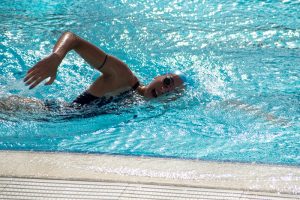 Swimming is a fun way to keep healthy and fit while making new friends. If you enjoy swimming and don’t particularly like other forms of exercise, swimming is the way to go. It is suitable for everyone, and its benefits are not only limited to physical activity but also extend to improved mental health. Health experts recommend 150 minutes of moderate activity or 75 minutes of vigorous activity weekly, making swimming the perfect tool for exercising your body and improving your cardiovascular health. Even better, if you hate running, swimming can burn as many calories as an hour of running without impacting your joints and bones. Keep reading to find out more about the fantastic benefits of swimming.
Swimming is a fun way to keep healthy and fit while making new friends. If you enjoy swimming and don’t particularly like other forms of exercise, swimming is the way to go. It is suitable for everyone, and its benefits are not only limited to physical activity but also extend to improved mental health. Health experts recommend 150 minutes of moderate activity or 75 minutes of vigorous activity weekly, making swimming the perfect tool for exercising your body and improving your cardiovascular health. Even better, if you hate running, swimming can burn as many calories as an hour of running without impacting your joints and bones. Keep reading to find out more about the fantastic benefits of swimming.
Full Body Workout
Swimming engages nearly all the muscles in the body, forcing the legs, torso, arms, and stomach to work simultaneously by propelling yourself into the water. The water buoyancy is also perfect for people with mobility issues since there is no pressure on the joints.
Additionally, 30 minutes in the water is almost equivalent to 45 minutes of the same exercises on land. Swimming also increases your heart rate without pressuring or stressing your body; it improves endurance, muscle strength, and tone. You can switch up various strokes to focus on different muscle groups such as backstroke, breaststroke, freestyle, butterfly, and sidestroke.
Swimming Is Ideal for All Ages
Anyone can learn to swim from a very young age and at their own pace. There are designated areas in the swimming pools for beginners and kids to practice and learn their swimming skills at a gradual pace under the supervision of a lifeguard. Kids require at least an hour of aerobic activity every day, and swimming is a fun way to keep fit without feeling like it is a chore. An Australian study has shown that swimming can increase children’s motor skills and enable them to master new skills earlier than kids who do not swim.
Swimming is also suitable for some people who struggle with other types of exercise. Ensure your kid(s) is under constant supervision to avoid the risk of drowning.
Improves Cardiovascular Strength
According to studies, women who swim half an hour a day reduce the risk of heart disease by 30 to 40 percent. Swimming provides low-impact cardio exercises making your heart and lungs stronger and enabling blood to pump more efficiently throughout your body.
Increased heart rate allows your body to burn more calories, fat, and energy while reducing blood pressure levels. Swimming also helps improve the flexibility of the cells lining the arteries, raises good cholesterol levels, minimizes the risk of a stroke, and controls blood sugar levels. Research also shows that swimming can help reduce inflammation that might lead to atherosclerosis due to increased cardio activity.
Swimming Burns Calories and Maintains a Healthy Weight
Swimming can effectively burn calories. You can burn over 250 calories in 30 minutes of recreational swimming and around 400 calories in vigorous swimming. This also depends on the swimming intensity and your body weight. This beats more than double cycling, running, and waking. For every ten minutes of swimming, you can lose weight from the different styles of swimming. For example, you can lose 80 calories from backstroke, 100 calories from freestyle, 60 calories in breaststroke, and 150 calories from butterfly stroke.
Swimming Reduces Stress and Improves Mental Health
Swimming helps the body to relax and de-stress by lowering anxiety and depression, relieving tension, improving sleeping patterns, and increasing energy levels. There is a lot of breathing control during swimming, forcing you to take deeper, controlled breaths, leading to a relieved and peaceful breathing rhythm.
Swimming can benefit people with fibromyalgia and multiple sclerosis symptoms by decreasing their anxiety and improving their mood. It can also help children with developmental disabilities better connect with family members. Additionally, swimming positively improves pregnant women’s mental health. All this can be attributed to the release of serotonin (a feel-good hormone), a mood stabilizer.
Another way swimming reduces stress levels is through the unique movement patterns in the water. When swimming in a horizontal position, the body gets rid of any accumulated pressure in the lower back and shoulders from the various activities you perform throughout the day.
Swimming Lowers the Risk of Diabetes
Swimming helps keep diabetes away and also benefits those who already have diabetes. Aerobic activity helps reduce the risk of diabetes or those with the condition by burning calories and improving cholesterol levels. You can try swimming at least thrice a week for a minimum of ten minutes to fully reap the benefits of swimming, then gradually increase the time and intensity as tolerated.
Ensure you monitor blood sugar levels and have a snack on standby if you have diabetes, and don’t forget to inform the lifeguard that you are diabetic for safety reasons. If you swim the breaststroke at least thrice a week for half an hour, you can reduce your risk of diabetes by over 10%. Swimming as a form of aerobic exercise may increase insulin sensitivity.
Swimming Can Help with Arthritis
Swimming can help with arthritis, disability, injury, and other conditions that may make high-impact exercises difficult. Water-based activities can help improve the use of the joints and limbs without aggravating arthritis or joint injuries. This is because the buoyancy of the water displaces the stress and weight on the joints. Water-based exercises can also help with joint stiffness and pain management while also helping improve injury recovery.
Swimming Can Help People with Asthma
Swimming helps improve breathing control and improve lung capacity. The humid air of indoor pools can help with asthma. Some studies indicate that the chlorine and chemical used to treat pools can worsen asthma symptoms and increase the risk for asthma. It can help if you use a pool with salty water instead of chlorine.
Swimming Improves Flexibility
Repetitively reaching, pulling, stretching, twisting and various strokes involved in swimming help improve body flexibility. Your arms and ankles become stretched out and flexible as you kick and push away from the water’s pressure and waves.
The Takeaway
Swimming has multiple health and recreational benefits for the body, mind, and soul. It is essential to stay hydrated and practice safe swimming practices and pool etiquette. If you are a first-timer, take swimming lessons and if possible, swim in areas that are under lifeguard supervision. Once you become a confident swimmer, you can try a few laps that keep your heart rate elevated for at least half an hour. If you feel exhausted, take breaks and do not exert yourself. Do not forget to have fun while at it.
For more information please contact Anderson Integrated Health Center.



